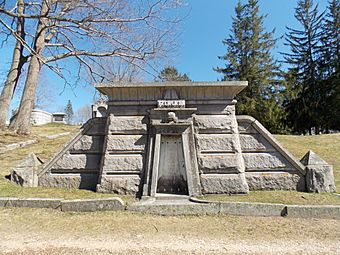F.O.J. Smith Tomb facts for kids
Quick facts for kids |
|
|
F.O.J. Smith Tomb
|
|
|
U.S. Historic district
Contributing property |
|
 |
|
| Location | Pond and Ash Aves. in Evergreen Cemetery, Stevens St., Portland, Maine |
|---|---|
| Area | 0.3 acres (0.12 ha) |
| Built | 1860 |
| Architectural style | Egyptian Revival architecture |
| Part of | Evergreen Cemetery (ID92000791) |
| NRHP reference No. | 74000166 |
| Added to NRHP | December 31, 1974 |
The F.O.J. Smith Tomb is a special historic tomb located in Evergreen Cemetery in Portland, Maine. It was built for Francis Ormand Jonathan Smith (1806–1876). He was a US Congressman from 1833 to 1839.
The tomb was likely built by Smith himself around 1860. This was when his daughter Lizzie passed away. It is a great example of Egyptian Revival architecture in Maine. This means it was designed to look like ancient Egyptian buildings. The tomb was added to the National Register of Historic Places in 1974. This list includes important historical sites in the United States.
Contents
What Does the Smith Tomb Look Like?
The Smith tomb is found in the western part of Evergreen Cemetery. This cemetery is a large, park-like burial ground. The tomb is made of granite, a strong type of stone. Most of it is covered by a mound of earth. Only the front part, called the facade, can be seen.
Egyptian Style Details
The tomb's front looks like an Egyptian pylon. A pylon is a large gateway found at the entrance of ancient Egyptian temples. It is built from rough granite blocks. The top has a rounded, sticking-out edge called a cornice. Smooth, cut stones cover the sloping sides of the front. They also form the pylon-shaped entrance.
Above the doorway, there is a sun disk design. This is a common symbol in Egyptian art. Below it, a panel shows "F.O.J.S." in raised letters. The door to the tomb is made of marble. It has a special message carved into it. This message talks about life, death, and believing in a greater power. It shares ideas about nature, religion, and the future.
Who Was F.O.J. Smith?
Francis Ormand Jonathan Smith was an interesting person in Maine's politics during the mid-1800s. He had many different political ideas. He supported different political groups, like the Whigs, Democrats, and Republicans. He was also involved in journalism.
Smith's Other Interests
Smith was an early supporter of the telegraph. This invention allowed messages to be sent over long distances using electrical signals. He helped Samuel F.B. Morse with his work on the telegraph. Smith also tried many different business ideas. Some of these business ventures did not succeed.
Moving the Tomb
His tomb was first built on his own land in Portland around 1860. This was about the time his daughter Lizzie died. In 1876, after Smith passed away, his land was divided up. The tomb and its contents were then moved to Evergreen Cemetery. It is believed that Smith himself designed this unique tomb.



